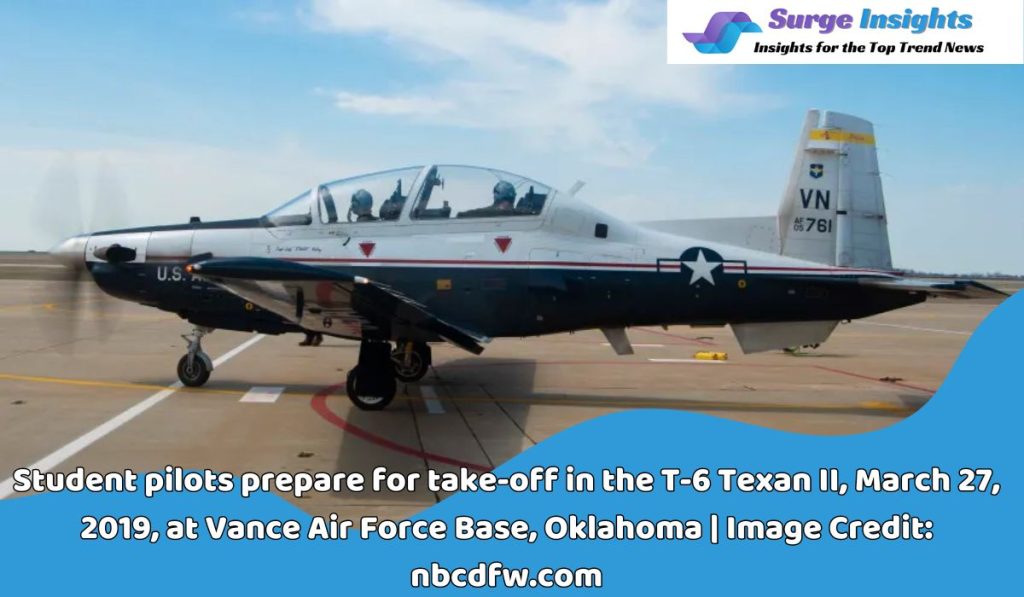
The investigation into the incident involving the T-6A Texan II aircraft is anticipated to be taken over by the Air Force Safety Investigation Board.
At Sheppard Air Force Base in Wichita Falls, Monday, the instructor pilot’s ejection seat activated while he was on the ground. The U.S. Air Force has identified the pilot.
The 80th Operations Support Squadron’s Capt. John Robertson was an instructor pilot when “the ejection seat of the T-6A Texan II aircraft he was in activated during ground operations,” according to the USAF, causing serious injuries.
In a statement, the air base stated that Robertson passed away on Tuesday due to his wounds.
Interesting Article: The Future of WAVR-297 Audio Technology
The interim wing commander, Col. Mitchell J. Cok, stated, “This is a tragic loss for the whole 80th Flying Training Wing as well as for Captain Robertson’s family and loved ones.” “Captain Robertson was an instructional pilot and highly esteemed airman. To everyone who knew and loved him, our sincere condolences are extended.
In addition, Cok expressed gratitude to the emergency response crew for their efforts in delivering first aid and medical attention, which enabled Robertson’s family to be present at his deathbed.
“We express our gratitude to the M1 maintenance crew for their prompt provision of life-sustaining treatment, as well as to the valiant efforts of the security forces, fire department, and medical staff at United Regional Hospital,” stated Cok.
One or two pilots can operate the training aircraft. According to an Air Force officer, there was no ejection and no injury to the student inside the aircraft.
The Air Force stated that an interim safety board inquiry is looking into the event and that a full Air Force Safety inquiry Board is scheduled to be in place later this week. The Air Force has not disclosed how the ejection seat may have been activated.
Aviation attorney Jon Kettles stated, “Ejection is a violent operation.”
Also Read: Valorant Account Economy Handbook: Advice on What & When to Buy
According to Kettles, a 2022 occurrence at Naval Air Station Joint Reserve Base Fort Worth serves as an illustration of what ought to happen during a seat ejection. He gestures at the moment when the pilot is launched just far enough to let the parachute fully expand before landing back on the ground.
“It’s likely that you may be hurt during an ejection, but it should only be minor injuries,” Kettles added.
He thinks it’s quite improbable that the eject lever was accidentally or purposefully pressed.
“Having operated an aircraft with an ejection seat, I can attest that while it’s nice to have it function when needed, if I were a pilot today, my biggest worry would be that the device would eject me during a routine flight even though I wouldn’t want it to,” said Kettles.
When the probe is over, the investigative board will make its findings on the event public, according to Sheppard AFB.
Robertson’s funeral is still pending; he was connected to Fort Worth.
TEXAN II TRAINER T-6A
The Air Force, Navy, and Marine Corps use the T-6A Texan II, a two-seater, single-engine turboprop aircraft, as their main training tool for fundamental flying abilities.
An Air Force dossier on the aircraft states that pilots access the T-6A cockpit by a single-piece canopy that opens from the side.
An instructor can take a seat in the front or rear during a training flight; both feature lightweight Martin-Baker ejection seats that are released by turning a handle on the seat.
Issues with the extraction seats
A pilot can escape an aircraft by grasping a handle, which initiates a multi-step emergency evacuation procedure. Taking hold of the handle causes the canopy of the aircraft to jettison or shatter, and then a cartridge explodes, propelling the pilot’s seat out of the aircraft and allowing them to parachute to safety.
When the handle is turned on, the complete ejection procedure just takes a few seconds.
Inspections in 2022 found a possible flaw in one of the cartridge actuated devices, or CADs, that controlled the ejection seat, leading to the grounding of the T-6 fleet along with hundreds of other Air Force, Navy, and Marine Corps aircraft. After a fleet inspection, the CADs were changed in a few cases.
Although they have been credited with saving pilots’ lives, ejection seats have malfunctioned during crucial moments in aircraft mishaps. Investigators found that 1st Lt. David Schmitz, 32, died in an F-16 collision in June 2020, with ejection seat failure contributing to his death.
When a B-1 bomber crew noticed one of the four ejection seats was malfunctioning while their aircraft was on fire in 2018, they were awarded the Distinguished Flying Cross. To give themselves the best chance of survival, the crew chose to land the flaming aircraft rather than jumping out. The group as a whole made it out alive.

Dwayne Paschke specializes in writing, management, development, design and Search Engine Optimization. Although he has worked for 8 years in the industry, he never found an ideal person to work with as a partner. Later, he found Sebastian Pearson, and they both found specific understanding between them. Both of them divided their tasks in this project and are running this venture successfully.
